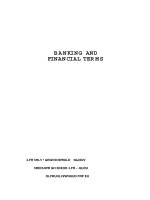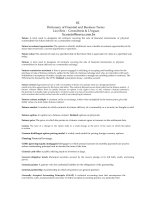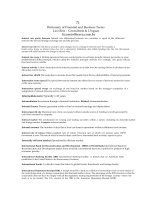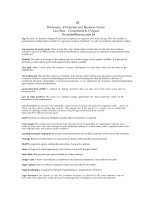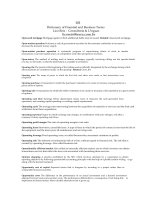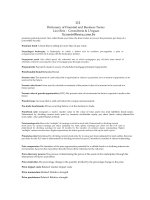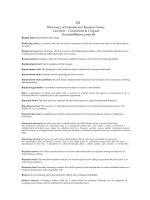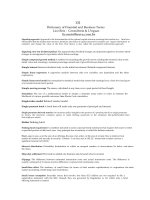Dictionary of Finantial and Business Terms part 1 pps
Bạn đang xem bản rút gọn của tài liệu. Xem và tải ngay bản đầy đủ của tài liệu tại đây (190.63 KB, 10 trang )
BANKING AND
FI N A N CI A L T E R M S
/
LFR 5HLV ² &RQVXOWRULD /tQJXDV
5REHUWR GH 3DXOD /LFR -~QLRU
OLFRUHLV#WHUUD FRP EU
*XDUDWLQJXHWi 6WDWH RI 6mR 3DXOR %UD]LO
LQ DQG UHVSHFWLYHO\ 1RZDGD\V KH OLYHV DQG ZRUNV LQ
,QWHUQDWLRQDO DQG ,PPLJUDWLRQ /DZ &LW\ 8QLYHUVLW\ (QJODQG
DQG 'LVWULEXWLYH 7UDGH (QJODQG LQ DQG WKH &RXUVHV LQ
$GYDQFHG 2YHUVHDV 7UDGH &RXUVH /RQGRQ &ROOHJH RI 3ULQWLQJ
6DOHVLDQD GH 'LUHLWR GH /RUHQD $QG KH DOVR FRQFOXGHG WKH
8QLYHUVLW\ ² (QJODQG ² DQG D %$ LQ /DZ 8QLYHUVLGDGH
GHJUHH LQ (XURSHDQ %XVLQHVV DQG /DQJXDJHV 6RXWK %DQN
R
oberto de Paula Lico J? nio
r
is a lecturer in English as a Foreign Language
and he has considerable expertise in the field of Overseas Trade, having
designed and taught a number of classes related to International Law
and Overseas Trade. He has a SRVWJUDGXDWH
The Author
2
Dictionary of Finantial and Business Terms
Lico Reis - Consultoria & L?nguas
Acquisition of stock :A merger or consolidation in which an acquirer purchases the acquiree's stock.
Acquisition of assets :A merger or consolidation in which an acquirer purchases the selling firm's assets.
Acquirer :A firm or individual that is acquiring something.
Acquiree :A firm that is being acquired.
Acid-test ratio :Also called the quick ratio, the ratio of current assets minus inventories, accruals, and prepaid items
to current liabilities.
Accumulated Benefit Obligation (ABO) :An approximate measure of the liabilit
y
of a plan in the event of a
termination at the date the calculation is performed. Related: projected benefit obligation.
Accrued interest :The accumulated coupon interest earned but not yet paid to the seller of a bond by the buyer
(unless the bond is in default).
Accrual bond :A bond on which interest accrues, but is not paid to the investor during the time of accrual. The
amount of accrued interest is added to the remaining principal of the bond and is paid at maturity.
Accretion (of a discount) :In portfolio accounting, a straight-line accumulation of capital gains on discount bond
in anticipation of receipt of par at maturity.
Accounts receivable turnover:The ratio of net credit sales to average accounts receivable, a measure of how
quickly customers pay their bills.
Accounts receivable:Money owed by customers.
Accounts payable:Money owed to suppliers.
Accounting liquidity:The ease and quickness with which assets can be converted to cash.
Accounting insolvency:Total liabilities exceed total assets. A firm with a negative net worth is insolvent on the
books.
Accounting earnings:Earnings of a firm as reported on its income statement.
Accounting exposure:The change in the value of a firm's foreign currency denominated accounts due to a change
in exchange rates.
Accelerated depreciation:An
y
depreciation method that produces lar
g
er deductions for depreciation in the earl
y
years of a project's life. Accelerated cost recovery system (ACRS), which is a depreciation schedule allowed for
tax purposes, is one such example.
Accelerated cost recovery system (ACRS):Schedule of depreciation rates allowed for tax purposes.
Absolute priority :Rule in bankruptc
y
proceedin
g
s whereb
y
senior creditors are required to be paid in full before
j
unior creditors receive an
y
pa
y
ment.
Abnormal returns:Part of the return that is not due to s
y
stematic influences (market wide influences). In other
words, abnormal returns are above those predicted by the market movement alone. Related: excess returns.
Abandonment option::The option of terminatin
g
an investment earlier than ori
g
inall
y
planned.
3
Dictionary of Finantial and Business Terms
Lico Reis - Consultoria & L?nguas
Agency problem Conflicts of interest among stockholders, bondholders, and managers.
are guaranteed by government agencies, such as
the Government National Mortgage Association (" Ginnie Mae
oan Mortgage Corp oration (" Freddi e Mac") and Federa l National Mort gage Associati on "), Federal Ho me L
(" Fannie Mae").
Agency pass-throughs
Mortgage pass-through securities whose principal and interest payments
Agency costs The incremental costs of having an agent make decisions for a principal.
Agency cost viewThe ar
g
ument that specifies that the various a
g
enc
y
costs create a complex environment in which
total agency costs are at a minimum with some, but less than 100%, debt financing.
Agency basis A means of compensating the broker of a program trade solely on the basis of commission
established through bids submitted by various brokerage firms. agency incentive arrangement. A means of
compensating the broker of a program trade using benchmark prices for issues to be traded in determining
commissions or fees.
Agency bank A form of organization commonly used by foreign banks to enter the U.S. market. An agency bank
cannot accept deposits or extend loans in its own name; it acts as agent for the parent bank.
Agencies Federal agency securities.
After-tax real rate of return Money after-tax rate of return minus the inflation rate.
After-tax profit margin The ratio of net income to net sales.
Affirmative covenant A bond covenant that specifies certain actions the firm must take.
Adverse selection A situation in which market participation is a ne
g
ative si
g
nal.
Advance commitment A promise to sell an asset before the seller has lined up purchase of the asset. This seller
can offset risk by purchasing a futures contract to fix the sales price.
Administrative pricing rules IRS rules used to allocate income on export sales to a foreign sales corporation.
Adjusted present value (APV) The net present value analysis of an asset if financed solely by equity (present
value of un-levered cash flows), plus the present value of any financing decisions (levered cash flows). In other
words, the various tax shields provided by the deductibility of interest and the benefits of other investment tax
credits are calculated separately. This analysis is often used for highly leveraged transactions such as a leverage
buy-out.
Adjustable rate preferred stock (ARPS) :Publicl
y
traded issues that ma
y
be collateralized b
y
mort
g
a
g
es and
MBSs.
Additional hedge :A protection a
g
ainst borrower fallout risk in the mort
g
a
g
e pipeline.
Actuals :The physical commodity underlying a futures contract. Cash commodity, physical.
Active portfolio strategy :A strate
gy
that uses available information and forecastin
g
techniques to seek a better
performance than a portfolio that is simply diversified broadly. Related: passive portfolio strategy
Active :A market in which there is much trading.
4
Dictionary of Finantial and Business Terms
Lico Reis - Consultoria & L?nguas
Act of state doctrine :This doctrine says that a nation is sovereign within its own borders and its domestic
actions may not be questioned in the courts of another nation.
American Depositary Receipts (ADRs) Certificates issued b
y
a U.S. depositar
y
bank, representin
g
forei
g
n shares held
b
y
the bank, usuall
y
b
y
a branch or correspondent in the countr
y
of issue. One ADR ma
y
represent a portion of
a foreign share, one share or a bundle of shares of a foreign corporation. If the ADR's
are "sponsored," the corporation provides financial information and other assistance to the bank and may
subsidize the administration of the ADRs. "Unsponsored" ADRs do not receive such assistance. ADRs carry
the same currency, political and economic risks as the underlying foreign share; the prices of the two, adjusted
Alternative mortgage instruments Variations of mort
g
a
g
e instruments such as ad
j
ustable-rate and variable- rate
several seldom-used mortgages, and mortgages,
variations.
graduated-payment mortgages, reverse-annuity
y = rate of return for the fund
x = rate of return for the S&P 500
b = beta of the fund
where: n =number of observations (36 months)
[ (sum of y) -((b)(sum of x)) ] / n
Alpha equationThe alpha of a fund is determined as follows:
Alpha A measure of selection risk (also known as residual risk) of a mutual fund in relation to the market. A positive
alpha is the extra return awarded to the investor for taking a risk, instead of accepting the market return. For
example, an alpha of 0.4 means the fund outperformed the market-based return estimate by 0.4%.
An alpha of -0.6 means a fund's monthly return was 0.6% less than would have been predicted from the change
in the market alone. In a Jensen Index, it is factor to represent the portfolio's performance that diverges from its
beta, representing a measure of the manager's performance.
All-or-none underwriting An arran
g
ement whereb
y
a securit
y
issue is canceled if the underwriter is unable to
re-sell the entire issue.
All-in cost Total costs, explicit and implicit.
All-equity rateThe discount rate that reflects onl
y
the business risks of a pro
j
ect and abstracts from the effects
of financing.
All or none Requirement that none of an order be executed unless all of it can be executed at the specified price.
All equity rate The discount rate that reflects onl
y
the business risks of a pro
j
ect and abstracts from the effects
of financing.
AIBD Association of International Bond Dealers.
Aging schedule A table of accounts receivable broken down into a
g
e cate
g
ories (such as 0-30 da
y
s, 30-60 da
y
s,
and 60-90 days), which is used to see whether customer payments are keeping close to schedule.
Aggregation Process in corporate financial plannin
g
whereb
y
the smaller investment proposals of each of the firm's
operational units are added up and in effect treated as a big picture.
Agent The decisio
n
-maker in a principal-a
g
ent relationship.
Agency theory The anal
y
sis of principal-a
g
ent relationships, wherein one person, an a
g
ent, acts on behalf of
anther person, a principal.
5
Dictionary of Finantial and Business Terms
Lico Reis - Consultoria & L?nguas
Annuity A re
g
ular periodic pa
y
ment made b
y
an insurance compan
y
to a polic
y
holder for a specified period of
time.
Annualized holding period return The annual rate of return that when compounded t times, would have given
the same t-period holding return as actually occurred from period 1 to period t.
Annualized gain If stock X appreciates 1.5% in one month, the annualized
g
ain for that sock over a twelve month
period is 12*1.5% = 18%. Compounded over the twelve month period, the gain is (1.015)^12 = 19.6%.
Annual report Yearl
y
record of a publicl
y
held compan
y
's financial condition. It includes a description of the firm's
operations, its balance sheet and income statement. SEC rules require that it be distributed to all shareholders.
A more detailed version is called a 10-K.
Annual percentage yield (APY) The effective, or true, annual rate of return. The APY is the rate actuall
y
earned or
paid in one year, taking into account the affect of compounding. The APY is calculated by taking one plus the
periodic rate and raising it to the number of periods in a year. For example, a 1% per month rate has an APY of
12.68% (1.01^12).
Annual percentage rate (APR) The periodic rate times the number of periods in a year. For example, a 5%
quarterly return has an APR of 20%.
Annual fund operating expenses For investment companies, the mana
g
ement fee and "other expenses,"
including the expenses for maintaining shareholder records, providing shareholders with financial statements, and
providing custodial and accounting services. For 12b-1 funds, selling and marketing costs are included.
Announcement date Date on which particular news concernin
g
a
g
iven compan
y
is announced to the public. Used
in event studies, which researchers use to evaluate the economic impact of events of interest.
Angels Individuals providin
g
venture capital.
Analyst Emplo
y
ee of a brokera
g
e or fund mana
g
ement house who studies companies and makes bu
y
-and-sell
recommendations on their stocks. Most specialize in a specific industry.
Amortizing interest rate swap Swap in which the principal or national amount rises (falls) as interest rates rise
(decline).
Amortization factor The pool factor implied by the scheduled amortization assuming no prepayemts.
Amortization The repayment of a loan by installments.
American-style option An option contract that can be exercised at an
y
time between the date of purchase and the
expiration date. Most exchange-traded options are American style.
American Stock Exchange (AMEX) The second-lar
g
est stock exchan
g
e in the United States. It trades
mostly in small-to medium-sized companies.
American shares Securities certificates issued in the U.S. by a transfer agent acting on behalf of the foreign issuer
The certificates represent claims to foreign equities.
American option An option that ma
y
be exercised at an
y
time up to and includin
g
the expiration date.
Related: European option
for the SDR/ordinar
y
ratio, are kept essentiall
y
identical b
y
arbitra
g
e. American depositar
y
shares(ADSs) are a
similar form of certification.
6
Dictionary of Finantial and Business Terms
Lico Reis - Consultoria & L?nguas
Asian option Option based on the average price of the asset during the life of the option.
Asian currency units (ACUs) Dollar deposits held in Singapore or other Asian centers.
Articles of incorporation Legal document establishing a corporation and its structure and purpose.
ARMs Ad
j
ustable rate mort
g
a
g
e. A mort
g
a
g
e that features predetermined ad
j
ustments of the loan interest rate at
re
g
ular intervals based on an established index. The interest rate is ad
j
usted at each interval to a rate equivalent
to the index value plus a predetermined spread, or margin, over the index, usually subject to per- interval and to
life-of-loan interest rate and/or payment rate caps.
Arm's length price The price at which a willing buyer and a willing unrelated seller would freely agree to
transact.
Arms index Also known as a tradin
g
index (TRIN)= (number of advancin
g
issues)/ (number of declinin
g
issues)
(Total up volume )/ (total down volume). An advance/decline market indicator. Less than 1.0 indicates bullish demand,
while above 1.0 is bearish. The index often is smoothed with a simple moving average.
Arithmetic mean return An avera
g
e of the subperiod returns, calculated b
y
summin
g
the subperiod returns and
dividing by he number of subperiods.
Arithmetic average (mean) rate of return Arithmetic mean return.
Arbitrageurs People who search for and exploit arbitra
g
e opportunities.
Arbitrage-free option-pricing models Yield curve option-pricing models.
Arbitrage Pricing Theory (APT) An alternative model to the capital asset pricin
g
model developed b
y
Stephen Ross and based purely on arbitrage arguments.
Arbitrage The simultaneous bu
y
in
g
and sellin
g
of a securit
y
at two different prices in two different markets,
resulting in profits without risk. Perfectly efficient markets present no arbitrage opportunities. Perfectly
efficient markets seldom exist.
Appropriation request Formal request for funds for capital investment project.
Appraisal rights A ri
g
ht of shareholders in a mer
g
er to demand the pa
y
ment of a fair price for their shares, as
determined independently.
Appraisal ratio The si
g
nal-to-noise ratio of an anal
y
st's forecasts. The ratio of alpha to residual standard
deviation.
Antidilutive effect Result of a transaction that increases earnings per common share (e.g. by decreasing the
number of shares outstanding).
Anticipation Arrangements whereby customers who pay before the final date may be entitled to deduct a normal
rate of interest.
Annuity in arrearsAn annuity with a first payment on full period hence, rather than immediately.
Annuity factor Present value of $1 paid for each of t periods.
Annuity due An annuit
y
with n pa
y
ments, wherein the first pa
y
ment is made at time t = 0 and the last
payment is made at time t = n - 1.
7
Dictionary of Finantial and Business Terms
Lico Reis - Consultoria & L?nguas
Assignment The receipt of an exercise notice b
y
an options writer that requires the writer to sell (in the case of a
call) or purchase (in the case of a put) the underlying security at the specified strike price.
Assets requirements A common element of a financial plan that describes pro
j
ected capital spendin
g
and the
proposed uses of net working capital.
Assets A firm's productive resources.
Asset pricing model A model, such as the Capital Asset Pricin
g
Model (CAPM), that determines the required rate
of return on a particular asset.
Asset turnover The ratio of net sales to total assets.
Asset swap An interest rate swap used to alter the cash flow characteristics of an institution's assets so as to
provide a better match with its iabilities.
Asset substitution problem Arises when the stockholders substitute riskier assets for the firm's existin
g
assets
and expropriate value from the debtholders.
Asset substitution A firm's investing in assets that are riskier than those that the debtholders expected.
Asset pricing model A model for determining the required rate of return on an asset.
Asset for asset swap Creditors exchan
g
e the debt of one defaultin
g
borrower for the debt of another
defaulting borrower.
Asset-coverage test A bond indenture restriction that permits additional borrowin
g
on if the ratio of assets to debt
does not fall below a specified minimum.
Asset classes Categories of assets, such as stocks, bonds, real estate and foreign securities.
Asset-based financing Methods of financin
g
in which lenders and equit
y
investors look principall
y
to the cash
flow from a particular asset or set of assets for a return on, and the return of, their financing.
Asset-backed security A security that is collateralized by loans, leases, receivables, or installment contracts on
personal property, not real estate.
Asset allocation decision The decision re
g
ardin
g
how an institution's funds should be distributed amon
g
the ma
j
or
classes of assets in which it may invest.
Asset activity ratios Ratios that measure how effectively the firm is managing its assets.
Asset/liability management Also called surplus mana
g
ement, the task of mana
g
in
g
funds of a financial
institution to accomplish the two goals of a financial institution: (1) to earn an adequate return on funds
invested and (2) to maintain a comfortable surplus of assets beyond liabilities.
Asset/equity ratio The ratio of total assets to stockholder equity.
Asset Any possession that has value in an exchange.
Ask price A dealer's price to sell a securit
y
; also called the offer price.
Ask This is the quoted ask, or the lowest price an investor will accept to sell a stock. Practicall
y
speakin
g
, this is the
quoted offer at which an investor can buy shares of stock; also called the offer price.
8
Dictionary of Finantial and Business Terms
Lico Reis - Consultoria & L?nguas
Average life Also referred to as the wei
g
hted-avera
g
e life (WAL). The avera
g
e number of
y
ears that each dollar
of unpaid principal due on the mortgage remains outstanding. Average life is computed as the weighted
Average cost of capital A firm's required pa
y
out to the bondholders and to the stockholders expressed as a
percentage of capital contributed to the firm. Average cost of capital is computed by dividing the total
required cost of capital by the total amount of contributed capital.
Average collection period, or days' receivables The ratio of accounts receivables to sales, or the total
amount of credit extended per dollar of daily sales (average AR/sales * 365).
Average age of accounts receivable The weighted-average age of all of the firm's outstanding invoices.
Average accounting return The avera
g
e pro
j
ect earnin
g
s after taxes and depreciation divided b
y
the avera
g
e book
value of the investment during its life.
Average An arithmetic mean of selected stocks intended to represent the behavior of the market or some
component of it. One good example is the widely quoted Dow Jones Industrial Avera
g
e, which adds the current
prices of the 30 DJIA's stocks, and divides the results by a predetermined number, the divisor.
Availability float Checks deposited by a company that have not yet been cleared.
Autoregressive Usin
g
past data to predict future data.
Automatic stay The restrictin
g
of liabilit
y
holders from collection efforts of collateral seizure, which is
automatically imposed when a firm files for bankruptcy under Chapter 11.
Automated Clearing House (ACH) A collection of 32 re
g
ional electronic interbank networks used to
process transactions electronically with a guaranteed one-day bank collection float.
Autocorrelation The correlation of a variable with itself over successive time intervals.
Authorized shares Number of shares authorized for issuance by a firm's corporate charter.
Auditor's report A section of an annual report containin
g
the auditor's opinion about the veracit
y
of the
financial statements.
Auction rate preferred stock (ARPS) Floating rate preferred stock, the dividend on which is adjusted every seven
weeks through a Dutch auction.
Auction markets Markets in which the prevailin
g
price is determined throu
g
h the free interaction of
prospective buyers and sellers, as on the floor of the stock exchange.
Attribute bias The tendency of stocks preferred by the dividend discount model to share certain equity attributes
such as low price-earnings ratios, high dividend yield, high book-value ratio or membership in a particular
industry sector.
At-the-money An option is at-the-money if the strike price of the option is equal to the market price of the
underlying security. For example, if xyz stock is trading at 54, then the xyz 54 option is at-the-money.
Asymmetric taxes A situation wherein participants in a transaction have different net tax rates.
Asymmetric information Information that is known to some people but not to other people.
Asymmetry A lack of equivalence between two thin
g
s, such as the unequal tax treatment of interest expense and
dividend payments.
9
Dictionary of Finantial and Business Terms
Lico Reis - Consultoria & L?nguas
Balance sheet identity Total Assets = Total Liabilities + Total Stockholders' Equity
Balance sheet exposure See:accounting exposure.
Balance sheet Also called the statement of financial condition, it is a summary of the assets, liabilities, and
owners' equity.
Balance of trade Net flow of goods (exports minus imports) between countries.
Balance of payments A statistical compilation formulated b
y
a soverei
g
n nation of all economic transactions
between residents of that nation and residents of all other nations during a stipulated period of time, usually a
calendar year.
Baker Plan A plan by U.S. Treasury Secretary James Baker under which 15 principal middle-income debtor countries
(the Baker 15) would undertake growth-oriented structural reforms, to be supported by increased financing from
the World Bank and continued lending from commercial banks.
Backwardation A market condition in which futures prices are lower in the distant deliver
y
months than in the
nearest delivery month. This situation may occur in when the costs of storing the product until eventual delivery
are effectively subtracted from the price today. The opposite of contango.
Back-up (1) When bond
y
ields and prices fall, the market is said to back-up. (2) When an investor swaps out of one
security into another of shorter current maturity he is said to back up.
Back-to-back loan A loan in which two companies in separate countries borrow each other's currency for a
specific time period and repay the other's currency at an agreed upon maturity.
Back-to-back financing An intercompany loan channeled through a bank.
Back-end loan fund A mutual fund that charges investors a fee to sell (redeem) shares, often ranging from
4% to 6%. Some back-end load funds impose a full commission if the shares are redeemed within a designated
time, such as one year. The commission decreases the longer the investor holds the shares. The formal name for
the back-end load is the contingent deferred sales charge, or CDSC.
Back officeBrokera
g
e house clerical operations that support, but do not include, the tradin
g
of stocks and other
securities. Includes all written confirmation and settlement of trades, record keeping and regulatory compliance.
Back fee The fee paid on the extension date if the buyer wishes to continue the option.
Away A trade, quote, or market that does not originate with the dealer in question, e.g., "the bid is 98-10 away
from me."
Average tax rate Taxes as a fraction of income; total taxes divided by total taxable income.
Average rate of return (ARR) The ratio of the average cash inflow to the amount invested.
Average (across-day) measures An estimation of price that uses the avera
g
e or representative price of a lar
g
e
number of trades.
Average maturity The avera
g
e time to maturit
y
of securities held b
y
a mutual fund. Chan
g
es in interest rates have
greater impact on funds with longer average life.
10
Dictionary of Finantial and Business Terms
Lico Reis - Consultoria & L?nguas
average time to the receipt of all future cash flows, using as the weights the dollar amounts of the principal
paydowns.


